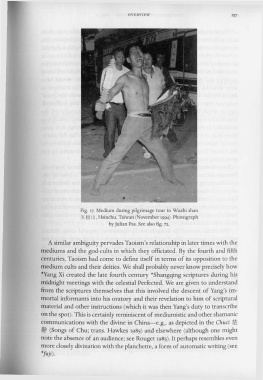Page 197 - The Encyclopedia of Taoism v1_A-L
P. 197
OV E RVi EW 157
•
Fig. 17. Medium during pilgrimage tour to Wuzhi shan
Ji lli LlJ, Hsinchu, Taiwan (November 1994). Photograph
by Julian Pas. See also fig. 72.
A similar ambiguity pervades Taoism's relationship in later times with the
mediums and the god-cults in which they officiated. By the fourth and fifth
centuries, Taoism had come to define itself in terms of its opposition to the
medium cults and their deities. We shall probably never know precisely how
*Yang Xi created the late fourth century *Shangqing scriptures during his
midnight meetings with the celestial Perfected. We are given to understand
from the scriptures themselves that this involved the descent of Yang's im-
mortal informants into his oratory and their revelation to him of scriptural
material and other instructions (which it was then Yang's duty to transcribe
on the spot). This is certainly reminiscent of mediumistic and other shamanic
communications with the divine in China-e.g., as depicted in the Chuci ~
~ (Songs of Chu; trans. Hawkes 1985) and elsewhere (although one might
note the absence of an audience; see Rouget 1985). It perhaps resembles even
more closely divination with the planchette, a form of automatic writing (see
*fuji).

